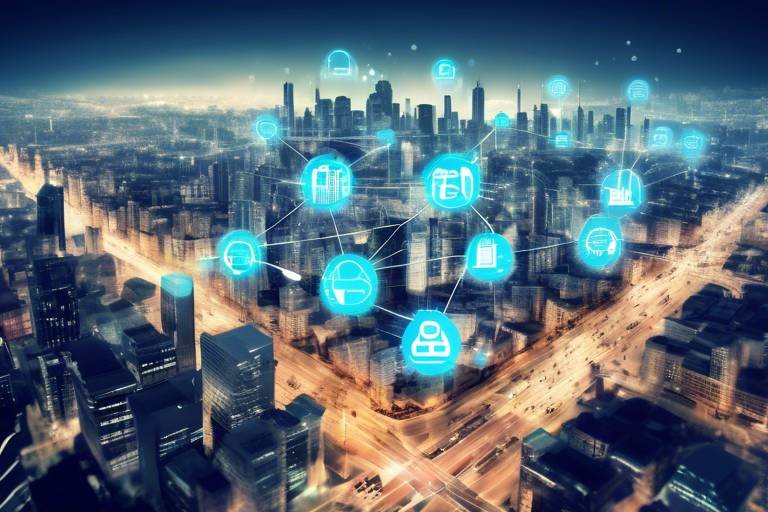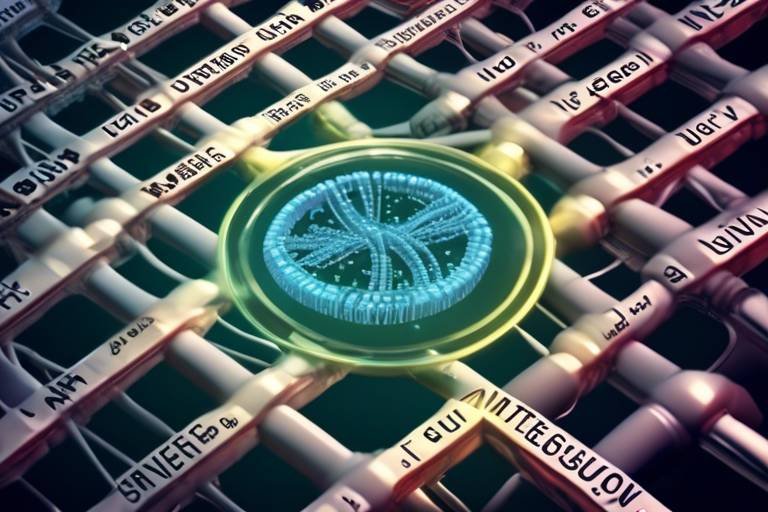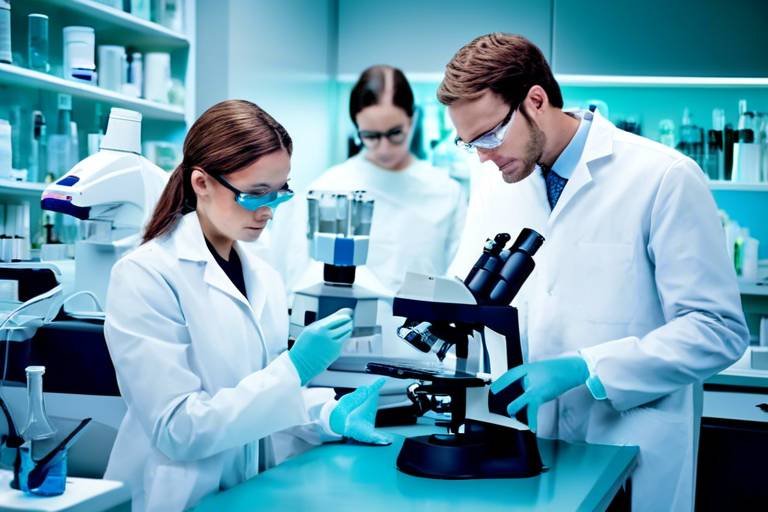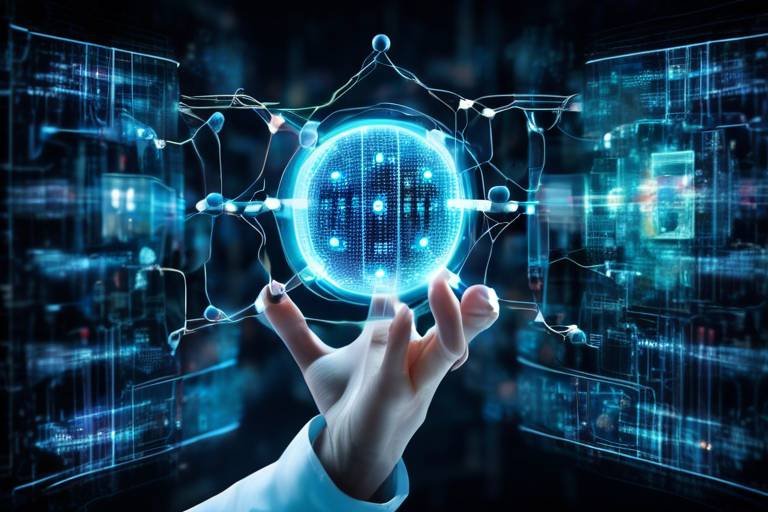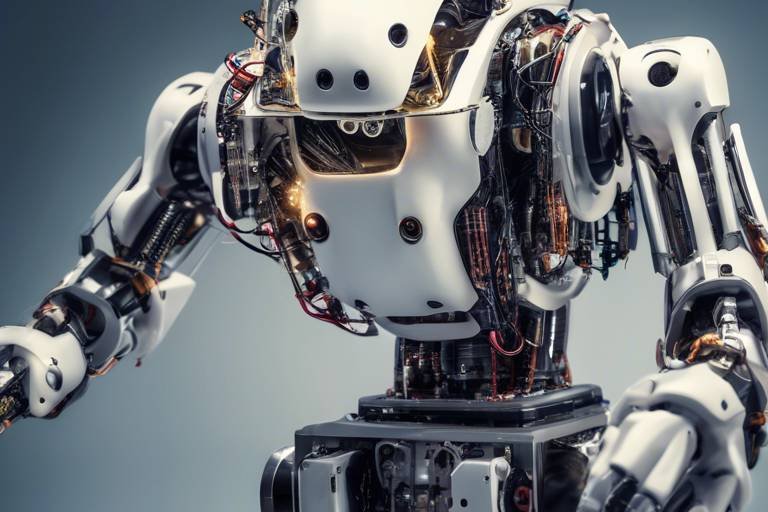The Intersection of Robotics and Human Interaction
In a world increasingly dominated by technology, the intersection of robotics and human interaction is a fascinating frontier that is reshaping our daily lives. Imagine waking up to a robotic assistant that not only brews your coffee but also engages you in a lively conversation about your day ahead. Sounds futuristic? It’s happening right now! Robotics has come a long way from the clunky machines of the past, evolving into sophisticated entities capable of understanding and responding to human emotions and needs.
As we delve into the implications of this evolution, it’s essential to consider how these advancements are not just altering the way we interact with machines but also influencing our social structures. The integration of robots into everyday life raises intriguing questions: How do we define companionship in an age where machines can mimic human emotions? What does it mean for our jobs when robots can perform tasks traditionally done by humans? These questions invite us to explore the profound changes in human dynamics brought about by robotics.
Moreover, the impact of robotics extends beyond mere convenience; it touches on the very fabric of our society. From healthcare to education, robots are becoming collaborators, assisting in tasks ranging from surgical procedures to tutoring students. This collaboration not only enhances efficiency but also fosters a new kind of relationship between humans and machines. As we navigate this new landscape, it's crucial to consider both the opportunities and challenges that lie ahead.
In this article, we will explore the evolution of robotics, the role of artificial intelligence, and the future of human-robot interaction. We will also delve into case studies that illustrate successful collaborations in various industries, ethical considerations surrounding these interactions, and the rise of social robots designed for companionship. By understanding these elements, we can better prepare for a future where humans and robots coexist harmoniously.
So, are you ready to embark on this journey into the world of robotics and human interaction? Let’s dive deeper!
- What are social robots? Social robots are designed to interact with humans in a social context, often providing companionship or assistance.
- How do robots impact jobs? While robots can enhance productivity, they may also lead to job displacement in certain sectors, prompting a need for workforce retraining.
- What ethical concerns are associated with robotics? Ethical concerns include privacy issues, decision-making in critical situations, and the moral responsibilities of creators and users.
- What is the future of human-robot interaction? The future may include advancements in natural language processing and emotional recognition, leading to more intuitive interactions.
The Evolution of Robotics
The journey of robotics is nothing short of fascinating, akin to a thrilling novel filled with unexpected twists and turns. From the rudimentary mechanical devices of the past to today's sophisticated intelligent machines, robotics has evolved dramatically over the centuries. Imagine a time when the concept of a robot was merely a figment of imagination, conjured up in the minds of inventors and dreamers. The first significant steps in this journey were taken during the 20th century, where early attempts at automation began to take shape. These initial creations were simple, often comprising gears and levers, designed to perform basic tasks. However, they laid the groundwork for what was to come.
As technology progressed, so did the complexity of these machines. The introduction of computers in the latter half of the 20th century marked a pivotal moment in robotics. Suddenly, robots were not just mechanical devices; they became programmable entities capable of performing a variety of tasks. This shift changed the way humans interacted with machines, leading to a more collaborative relationship. The 21st century ushered in a new era of robotics, characterized by the integration of artificial intelligence (AI), which has revolutionized human-robot interaction.
Today, robots can learn from their environments, adapt to new situations, and even communicate with humans in natural language. This evolution has transformed industries across the globe. For example, in manufacturing, robots work alongside humans on assembly lines, enhancing productivity and efficiency. In healthcare, robotic surgical systems assist surgeons in complex procedures, improving precision and patient outcomes. The implications of these advancements are profound, as they not only streamline processes but also redefine the roles of human workers.
Throughout this evolution, several key milestones stand out, highlighting the rapid advancements in this field:
- 1950s-1960s: The birth of industrial robots, such as George Devol's Unimate, which was the first robot to be used in a production line.
- 1980s: The introduction of robots in various sectors, including automotive manufacturing, paving the way for widespread adoption.
- 2000s: The rise of humanoid robots like ASIMO, designed to interact with people and navigate complex environments.
- 2010s-Present: The integration of AI and machine learning, enabling robots to learn from experience and improve their interactions with humans.
This evolution raises compelling questions about the future of human-robot interaction. As robots become more integrated into our daily lives, the lines between human and machine blur. Will we embrace these machines as partners, or will we fear their potential to replace us? The answer lies in our ability to adapt and redefine our roles in this new landscape. As we stand on the brink of a robotic future, understanding the evolution of robotics is crucial for navigating the challenges and opportunities that lie ahead.
The Role of AI in Robotics
Artificial Intelligence (AI) has emerged as a game-changer in the field of robotics, transforming how machines interact with the world and, more importantly, with us. Imagine a world where robots not only perform tasks but also understand and respond to human emotions. This is not science fiction; it's the reality we are stepping into. AI enhances robots' capabilities by enabling them to learn from their environments, make decisions, and communicate effectively with humans, leading to more intuitive and seamless interactions.
One of the most significant advancements in AI is its ability to process vast amounts of data quickly. This capability allows robots to adapt to new situations and improve their performance over time. For instance, consider a robotic vacuum cleaner that learns the layout of your home. Initially, it may take longer to clean the entire area, but as it gathers data about furniture placement and room sizes, it becomes more efficient. This concept of learning and adapting is central to the integration of AI in robotics.
Moreover, the integration of AI in robotics facilitates enhanced communication. Robots equipped with natural language processing (NLP) can understand and respond to verbal commands, making interactions feel more natural. This capability is particularly beneficial in settings such as healthcare, where robots can assist patients by providing information or reminders. Imagine a robot that can remind elderly patients to take their medications on time, all while conversing with them in a friendly manner. This not only helps in medication adherence but also provides companionship, reducing feelings of isolation.
However, the implications of AI in robotics extend beyond mere convenience. As robots become more capable of decision-making, we must consider the ethical implications of these advancements. For example, in scenarios where robots are tasked with critical decisions—like in autonomous vehicles or surgical robots—the stakes are incredibly high. How do we ensure that these machines make the right choices? This is where the responsibility of creators and users comes into play. The design and programming of AI systems must incorporate ethical considerations to prevent potential misuse or harm.
To further illustrate the profound impact of AI on robotics, let's look at some key areas where this integration is transforming industries:
| Industry | AI Application | Impact |
|---|---|---|
| Manufacturing | Predictive maintenance | Reduces downtime and increases efficiency |
| Healthcare | Patient monitoring | Improves patient outcomes through timely interventions |
| Agriculture | Crop monitoring | Enhances yield through data-driven decisions |
In summary, the role of AI in robotics is not just about enhancing machine capabilities; it's about redefining how we interact with technology. As these intelligent machines become more integrated into our daily lives, the potential for collaboration between humans and robots grows exponentially. However, with this potential comes the responsibility to ensure that these interactions are safe, ethical, and beneficial for society as a whole.
- What is the primary benefit of integrating AI into robotics? The primary benefit is enhanced communication and decision-making abilities, leading to more effective interactions between humans and robots.
- How does AI enable robots to learn? AI allows robots to process data from their environments, helping them adapt and improve their performance over time.
- What ethical concerns arise from AI in robotics? Ethical concerns include ensuring robots make the right decisions in critical situations and the responsibility of creators to prevent misuse.
- Can robots with AI provide companionship? Yes, social robots equipped with AI can engage in conversation and provide companionship, particularly to the elderly or isolated individuals.
Human-Robot Collaboration
In today's fast-paced world, the concept of is not just a futuristic dream; it's a reality transforming various industries. Imagine a factory floor where robots and humans work side by side, seamlessly integrating their strengths to achieve unprecedented levels of efficiency. This collaboration is akin to a well-rehearsed dance, where each partner knows their role, timing, and movements, creating a harmonious outcome that benefits everyone involved.
One of the most exciting aspects of human-robot collaboration is how it enhances productivity. Robots can perform repetitive tasks with precision and speed, allowing humans to focus on more complex, creative, and strategic responsibilities. For instance, in manufacturing, robots are often tasked with heavy lifting or intricate assembly processes, while human workers oversee quality control and innovation. This division of labor not only boosts productivity but also improves job satisfaction, as employees can engage in more meaningful work.
However, the rise of robots in the workplace also raises important questions about job displacement. While some fear that robots will replace human jobs, it's crucial to understand that collaboration can lead to the creation of new roles that require human oversight, creativity, and emotional intelligence—qualities that robots simply cannot replicate. For example, in the healthcare sector, robots assist in surgeries and patient care, but the empathy and decision-making skills of healthcare professionals remain irreplaceable.
To illustrate the impact of human-robot collaboration, let's take a look at some key sectors:
| Industry | Role of Robots | Benefits |
|---|---|---|
| Manufacturing | Assembly, quality control | Increased efficiency, reduced errors |
| Healthcare | Assisting in surgeries, patient monitoring | Improved precision, enhanced patient care |
| Agriculture | Planting, harvesting, monitoring crops | Higher yields, reduced labor costs |
Despite the advantages, the dynamics of collaboration between humans and robots are complex. It requires a shift in mindset and culture within organizations. Companies must foster an environment where human workers feel comfortable working alongside machines, understanding their capabilities and limitations. Training programs that emphasize collaborative skills and technological proficiency will be essential in preparing the workforce for this new reality.
Moreover, the integration of robots into the workplace should be approached with caution. It's essential to address the ethical implications of such collaborations. Questions about accountability, transparency, and the potential for bias in automated decision-making systems must be at the forefront of discussions. As we navigate this new terrain, we must ensure that technology serves to enhance human capabilities rather than diminish them.
In summary, human-robot collaboration is not merely a trend; it's a fundamental shift in how we approach work. By embracing this partnership, we can harness the strengths of both humans and robots, paving the way for a future where innovation and efficiency thrive together. As we continue to explore and refine these collaborations, the potential for growth and improvement in various sectors is boundless.
- Will robots take over all jobs? While robots may automate certain tasks, they also create new job opportunities that require human skills.
- How can companies prepare for human-robot collaboration? Companies should invest in training and development programs that focus on collaborative skills and technological literacy.
- What are the ethical considerations of using robots in the workplace? It's crucial to address issues of accountability, bias, and transparency in automated systems to ensure ethical practices.
Case Studies in Industry
The integration of robotics into various industries has not only transformed operational efficiencies but has also redefined the way human workers engage with technology. One of the most compelling examples can be found in the manufacturing sector, where robotic arms have become invaluable assets on assembly lines. These machines, equipped with advanced sensors and AI algorithms, can perform repetitive tasks with precision and speed, allowing human workers to focus on more complex problem-solving roles. As a result, companies have reported a significant boost in productivity, with some experiencing increases of up to 30% in output.
In the healthcare industry, robots are proving to be lifesavers—literally. Surgical robots, such as the da Vinci Surgical System, have revolutionized minimally invasive surgeries. These robots provide surgeons with enhanced dexterity and control, leading to shorter recovery times for patients and reduced risk of complications. For instance, a case study at a leading hospital demonstrated that patients undergoing robotic-assisted prostatectomies had a 50% lower rate of complications compared to traditional methods, showcasing how robotics can enhance patient care and outcomes.
Moreover, agriculture is witnessing a robotic renaissance with the advent of autonomous farming equipment. Drones and robotic harvesters are optimizing crop management and harvesting processes. A notable case is that of a vineyard in California that implemented robotic systems for grape harvesting. The robots not only reduced labor costs but also improved the quality of the harvest by ensuring that grapes were picked at the perfect ripeness. This synergy between human expertise and robotic efficiency is paving the way for sustainable farming practices.
However, these advancements do not come without challenges. The introduction of robots into the workforce raises questions about job displacement and the evolving role of human workers. While robots can take over mundane tasks, there is a growing need for skilled workers who can manage and maintain these complex machines. A recent survey revealed that 67% of manufacturing executives believe that retraining workers is crucial for a successful transition to a more automated environment. This highlights the importance of collaboration between humans and robots, where each complements the other's strengths.
As we delve deeper into these case studies, it becomes clear that the relationship between humans and robots is not merely one of replacement but rather one of collaboration. The stories from manufacturing, healthcare, and agriculture illustrate a future where robots enhance human capabilities rather than diminish them. By embracing this partnership, industries can unlock unprecedented levels of efficiency and innovation.
- How are robots affecting job opportunities? While robots can automate certain tasks, they also create new roles in managing and maintaining robotic systems, leading to a shift in job requirements rather than outright job loss.
- What industries are most impacted by robotics? Manufacturing, healthcare, and agriculture are currently leading the way in robotic integration, but other sectors like logistics and retail are also beginning to adopt robotic solutions.
- Are there ethical concerns regarding robots in the workplace? Yes, ethical considerations include job displacement, privacy issues, and the responsibility of creators to ensure robots are used safely and effectively.
Ethical Considerations
As we stand on the brink of a robotic revolution, the ethical implications of human-robot interaction cannot be overlooked. The integration of robots into our daily lives raises a myriad of questions that challenge our moral compass. For instance, when a robot makes a decision in a critical situation, who is held accountable? Is it the robot, the programmer, or the user? This dilemma is particularly pressing in fields like healthcare, where robotic systems may assist in surgeries or patient care. The stakes are high, and the lines between responsibility and accountability blur.
Moreover, the issue of privacy comes into play. As robots become more sophisticated, they will likely collect vast amounts of data about their users. This data could include personal preferences, health information, and even emotional states. The question arises: how do we ensure that this information is safeguarded? The potential for misuse is significant, and it’s vital that developers implement robust privacy measures to protect users from breaches.
Another ethical consideration is the impact of robotics on employment. While robots can enhance productivity and efficiency, they also pose a threat to jobs traditionally held by humans. This raises a fundamental question: What is the value of human labor in a world increasingly populated by machines? As robots take on more tasks, we must consider the implications for job displacement and the need for reskilling the workforce. Should we be concerned about a future where human skills become obsolete?
Furthermore, the moral responsibilities of creators and users must be examined. Developers have a duty to ensure that their robots operate within ethical guidelines, while users must understand the implications of their interactions with these machines. A collaborative approach is necessary to navigate these complex ethical landscapes. To facilitate this dialogue, stakeholders from various sectors—technology, ethics, law, and sociology—must come together to establish frameworks that guide the development and use of robotic technologies.
In light of these considerations, it is essential to establish a set of ethical guidelines that govern the design and deployment of robots. These guidelines should address key issues such as:
- Accountability: Clearly define who is responsible for the actions of robots.
- Privacy: Implement strict data protection measures to safeguard user information.
- Employment: Create strategies for workforce reskilling to mitigate job displacement.
- Transparency: Ensure that users are informed about how robots operate and make decisions.
Ultimately, as we forge ahead into this new era, it is crucial to maintain a balance between technological advancement and ethical responsibility. By addressing these ethical considerations head-on, we can pave the way for a future where humans and robots coexist harmoniously, enhancing our lives rather than complicating them.
Q: What are the main ethical concerns regarding human-robot interaction?
A: The primary ethical concerns include accountability for robot decisions, privacy of user data, the impact on employment, and the moral responsibilities of developers and users.
Q: How can we ensure robots are designed ethically?
A: Establishing clear ethical guidelines, involving stakeholders from various sectors, and implementing robust privacy measures can help ensure ethical robot design.
Q: What is the impact of robots on employment?
A: While robots can improve efficiency and productivity, they may also displace jobs, necessitating reskilling and adaptation for the workforce.
Q: Who is responsible if a robot causes harm?
A: The responsibility may fall on the robot's programmer, the user, or the manufacturer, depending on the circumstances and existing legal frameworks.
Social Robots and Companionship
In recent years, the emergence of social robots has transformed the landscape of human interaction, particularly in the realm of companionship. These robots, designed to engage with humans on an emotional level, are not just machines; they are companions that can provide comfort, support, and even friendship. Imagine coming home after a long day and being greeted by a robot that knows your favorite TV shows, remembers your preferences, and can even hold a conversation. Sounds like science fiction, right? Well, it's becoming a reality!
Social robots are equipped with advanced artificial intelligence that allows them to recognize human emotions and respond accordingly. This capability is particularly beneficial for individuals who may feel isolated or lonely, such as the elderly or those with disabilities. For instance, a study published in the Journal of Human-Robot Interaction found that elderly individuals who interacted with social robots reported improved mood and reduced feelings of loneliness. These robots serve as a bridge, connecting people to the world around them in ways that were previously unimaginable.
Moreover, the role of social robots extends beyond mere companionship. They can assist with daily tasks, provide reminders for medication, or even facilitate communication for those with speech impairments. The versatility of these robots is astounding, and they are becoming increasingly integrated into various aspects of our lives. For example, robots like Paro, a therapeutic robotic seal, have been used in nursing homes to help soothe patients with dementia. The gentle interactions with Paro not only bring joy but also stimulate memories and emotional responses that can enhance the quality of life for these individuals.
However, while the benefits of social robots are evident, they also raise important questions about the nature of human relationships. Can a robot truly understand human emotions, or is it merely mimicking responses? The emotional bond that forms between humans and robots can be profound, but it also challenges our traditional notions of companionship. Are we at risk of replacing human connections with robotic ones? These are questions that society must grapple with as we continue to integrate robots into our daily lives.
As we look to the future, the potential for social robots to enrich our lives is enormous. With advancements in natural language processing and emotional recognition, these robots will become even more adept at understanding and responding to human needs. Imagine a world where your robot companion not only understands your words but can also read your body language and tone of voice, making interactions feel more genuine and fulfilling.
In conclusion, social robots represent a fascinating intersection of technology and human interaction. They offer companionship, support, and even joy to those who need it most. As we embrace these innovations, it’s crucial to maintain a balance—ensuring that while we welcome our robotic companions, we also cherish and nurture our human relationships. The future of companionship may very well lie in the harmonious coexistence of humans and robots, each enriching the other's experience in this ever-evolving world.
- What are social robots? Social robots are designed to interact with humans on an emotional level, providing companionship and support.
- How do social robots help with loneliness? They offer engaging interactions that can alleviate feelings of isolation, especially in vulnerable populations like the elderly.
- Can social robots understand human emotions? While they can recognize and respond to emotional cues, their understanding is based on programmed algorithms rather than genuine empathy.
- What are some examples of social robots? Examples include Paro, the therapeutic robotic seal, and various humanoid robots designed for companionship.
- Will social robots replace human relationships? While they can provide companionship, they are not a substitute for human connections and should be seen as a complement to them.
The Future of Human-Robot Interaction
The future of human-robot interaction is not just a figment of science fiction; it's a reality that's rapidly unfolding before our eyes. As we stand on the brink of what many are calling the Fourth Industrial Revolution, the integration of robotics and artificial intelligence (AI) is set to redefine how we live, work, and communicate. Imagine a world where robots not only assist us in our daily tasks but also understand our emotions and respond accordingly. This isn't just a dream—it's a potential future that is becoming increasingly tangible.
One of the most exciting aspects of this future is the potential for enhanced communication between humans and robots. With advancements in natural language processing, robots will be able to engage in conversations that feel more human-like. Imagine having a chat with your robotic assistant, where it not only understands your commands but also picks up on your tone and mood. This could lead to a more intuitive interaction, making technology feel less like a tool and more like a companion. As we move forward, the line between human and machine communication is expected to blur, creating a seamless interface that enhances our experiences.
Moreover, as robots become more integrated into our lives, their emotional recognition capabilities will evolve. Future robots may be equipped with sensors that allow them to read facial expressions, vocal tones, and even body language. This capability will enable them to respond to our feelings in real-time, fostering a deeper connection. For instance, a social robot designed for companionship could sense when you're feeling down and offer comforting words or even engage in activities you enjoy. This level of interaction can have profound implications for mental health, as robots could serve as companions for those who feel isolated.
In various industries, the collaboration between humans and robots will continue to grow, leading to increased efficiency and productivity. Consider the healthcare sector, where robots are already assisting in surgeries and patient care. The future may see robots handling routine tasks, allowing healthcare professionals to focus on more complex patient interactions. This shift not only enhances productivity but also improves the quality of care. However, it raises questions about the future of jobs in these sectors, which we must address proactively.
To prepare for this robotic future, society must take several essential steps. Education will play a crucial role in equipping the workforce with the skills needed to work alongside robots. As robotics and AI technologies continue to evolve, adapting our educational systems to include relevant training will ensure that individuals are not left behind. Additionally, policymakers must create frameworks that address the ethical implications of human-robot interactions, ensuring that these technologies are developed and used responsibly.
As we look ahead, the possibilities are limitless. Emerging technologies such as advanced sensory capabilities and machine learning will continue to drive innovation in human-robot interaction. The robots of tomorrow will not only be smarter but also more empathetic, capable of understanding and responding to human emotions in ways we can only begin to imagine. However, with great power comes great responsibility, and it is essential that we navigate this future thoughtfully.
- Will robots take over all jobs? While robots will automate certain tasks, they are also expected to create new job opportunities, particularly in tech and maintenance roles.
- How will robots affect human relationships? Robots designed for companionship can enhance social interactions, especially for individuals who may feel isolated.
- What ethical considerations are involved with robots? Key concerns include privacy, decision-making in critical situations, and the moral responsibilities of those who create and use robotic technologies.
- How can we prepare for a future with robots? Fostering education in robotics and AI, along with creating supportive policies, will be crucial for a harmonious coexistence with robots.
Technological Innovations on the Horizon
As we stand on the brink of a new era in technology, the future of human-robot interaction is brighter than ever. Innovations are not just around the corner; they are already reshaping our understanding of what robots can do and how they can work alongside us. Imagine a world where robots can understand our emotions, engage in meaningful conversations, and even anticipate our needs. This is not science fiction; it’s becoming our reality.
One of the most exciting advancements is in the field of natural language processing (NLP). Thanks to breakthroughs in machine learning algorithms, robots are becoming increasingly adept at understanding human language nuances. This means that the days of robotic voices misinterpreting commands are numbered. Instead, we can look forward to seamless conversations where robots can respond appropriately based on context and emotion. For instance, a healthcare robot could provide comforting words to a patient, making their experience less daunting.
Another groundbreaking innovation is the development of emotional recognition technology. By using advanced sensors and machine learning, robots can now read human facial expressions and body language. This capability allows them to gauge our emotional state and respond accordingly. Imagine a social robot that can detect when you’re feeling down and offer support, or a customer service bot that can sense frustration and adjust its responses to help alleviate your concerns. The implications for mental health support and customer service are profound.
Moreover, the integration of advanced sensory capabilities is set to revolutionize how robots perceive their environment. With improved vision, touch, and even smell, robots will be able to interact with the world more like humans do. For example, in agriculture, robots equipped with enhanced sensory technology can detect ripe fruits or assess soil health, leading to more efficient farming practices. This not only boosts productivity but also contributes to sustainable agriculture.
To illustrate these innovations, consider the following table that outlines some of the key technological advancements expected in the near future:
| Innovation | Description | Potential Applications |
|---|---|---|
| Natural Language Processing | Improved understanding of human language and context. | Customer service, healthcare, education. |
| Emotional Recognition | Ability to read and respond to human emotions. | Mental health support, social interaction. |
| Advanced Sensory Capabilities | Enhanced vision, touch, and smell for environmental interaction. | Agriculture, manufacturing, home assistance. |
As these technologies continue to evolve, the relationship between humans and robots will undoubtedly deepen. It’s not just about efficiency anymore; it’s about creating a connection. The robots of tomorrow will not only assist us but will also understand us, paving the way for a collaborative future that enhances our lives in unimaginable ways.
However, with these advancements come responsibilities. We must ensure that the development of such technologies is guided by ethical considerations and that we create systems that prioritize human welfare. As we embrace these innovations, we need to ask ourselves: how can we harness them to foster a better world for everyone?
- What is natural language processing?
Natural language processing (NLP) is a technology that enables computers to understand, interpret, and respond to human language in a meaningful way.
- How can robots recognize emotions?
Robots can use sensors and algorithms to analyze human facial expressions, voice tone, and body language to determine emotional states.
- What are the applications of advanced sensory capabilities in robots?
These capabilities can be applied in various fields, including agriculture for crop monitoring, manufacturing for quality control, and home assistance for improved interaction.
Preparing for a Robotic Future
As we stand on the brink of a new era defined by robotics and artificial intelligence, the question arises: how do we prepare for a future where machines and humans coexist more intimately than ever before? The answer isn't simple, but it involves a multifaceted approach that considers education, policy-making, and public awareness. Imagine a world where robots are not just tools but partners in our daily lives, enhancing our capabilities while also challenging our perceptions of work and companionship.
First and foremost, education must evolve. Schools should integrate robotics and AI into their curriculums, ensuring that future generations are not only consumers of technology but also creators. This means teaching coding, engineering principles, and the ethical implications of AI from a young age. By doing so, we empower students to understand and shape the technology that will define their future. Picture a classroom where children are not just learning about robots but are actually building and programming them—this hands-on experience will foster innovation and critical thinking.
Moreover, policy-making plays a crucial role in shaping our robotic future. Governments need to establish frameworks that ensure the safe and ethical use of robotics. This includes regulations on data privacy, safety standards for robotic systems, and guidelines for human-robot interactions. For instance, as robots become more integrated into healthcare settings, policies must address how patient data is handled and ensure that human oversight remains a priority. Without clear regulations, the rapid advancement of technology could outpace our ability to manage its consequences, leading to unforeseen challenges.
Public awareness and dialogue are equally important. Society must engage in discussions about the implications of robotics, addressing both the benefits and the challenges. For example, while robots can increase efficiency and productivity, they also raise questions about job displacement. Creating forums for these conversations allows individuals to voice their concerns and hopes for a robotic future. It’s essential to bridge the gap between technologists and the general public, fostering an environment where everyone feels informed and included in the dialogue about these transformative technologies.
In preparing for a robotic future, we must also consider our emotional and social readiness. As robots take on roles traditionally held by humans, such as caregivers or companions, we need to reflect on how these changes impact our relationships. Will we accept robots as part of our social fabric? Will we be comfortable with machines playing significant roles in our lives? Addressing these questions requires an open mind and a willingness to adapt to new forms of interaction.
In conclusion, preparing for a robotic future is not merely about embracing technology; it’s about fostering a holistic approach that includes education, policy, and public engagement. By taking these steps, we can ensure that our society not only survives but thrives in the face of rapid technological advancement. As we move forward, let’s remember that the ultimate goal is to create a future where humans and robots can coexist harmoniously, enhancing each other’s lives in ways we are just beginning to imagine.
- What skills will be important in a robotic future? Skills in programming, robotics, and understanding AI ethics will be crucial.
- Will robots take away jobs? While some jobs may be displaced, new opportunities will also emerge in fields related to robotics and AI.
- How can we ensure robots are used ethically? Through robust policy-making and public dialogue, we can establish guidelines for ethical robot use.
- What role will education play in this transition? Education will need to adapt to include robotics and AI in the curriculum to prepare future generations.
Frequently Asked Questions
- What is the main focus of the article on robotics and human interaction?
The article delves into how robotics is transforming the way we interact with each other and machines. It highlights the implications for society and explores future collaborations between humans and robots across various fields.
- How has robotics evolved over the years?
Robotics has come a long way from simple mechanical devices to sophisticated intelligent machines. This evolution has significantly influenced human interaction, making it more efficient and integrated into our daily lives.
- What role does artificial intelligence play in robotics?
Artificial intelligence enhances the capabilities of robots, allowing them to communicate better and make informed decisions. This integration leads to more effective interactions between humans and robots, making them valuable partners in various tasks.
- Can you give examples of human-robot collaboration?
Absolutely! In industries like manufacturing, healthcare, and agriculture, robots work alongside humans to boost efficiency and productivity. These collaborations not only improve outcomes but also raise important questions about job displacement and teamwork dynamics.
- What ethical considerations arise from human-robot interaction?
There are several ethical implications to consider, such as privacy concerns, the role of robots in critical decision-making, and the moral responsibilities of both creators and users. It’s crucial to navigate these issues thoughtfully as technology advances.
- What are social robots, and how do they affect human relationships?
Social robots are designed for companionship and can positively impact mental health by providing emotional support. They are changing the dynamics of human relationships by offering a new form of interaction that some people find comforting.
- What does the future hold for human-robot interaction?
The future promises exciting advancements in robotics and AI, potentially redefining how we communicate and collaborate with machines. Innovations in natural language processing and emotional recognition could lead to even more seamless interactions.
- How can society prepare for an increasingly robotic world?
To adapt to a robotic future, society must focus on education, policy-making, and raising public awareness. These steps will help ensure a harmonious coexistence between humans and robots, maximizing the benefits while minimizing the challenges.





